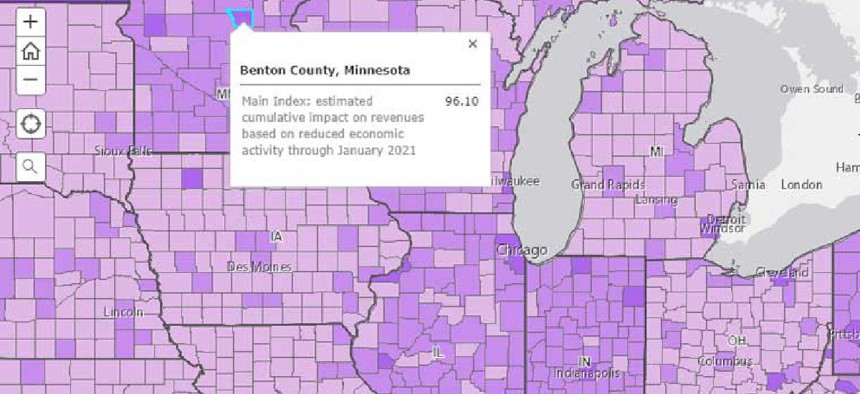Better data helps state, local governments map COVID pandemic’s economic impact

Data tools developed by Argonne National Laboratory provide insight into estimated losses in fees, taxes and other revenue sources that impact economic activity.
To help state and local governments identify revenue downturns resulting from the COVID-19 pandemic and other disruptive events, the Argonne National Laboratory developed data tools that provide insight into estimated losses in fees, taxes and other revenue sources that impact economic activity.
The State Government Revenue Vulnerability Index (SGRVI) and the county-level Local Government Vulnerability Index (LGRVI) compare monthly revenue changes to a January 2020 baseline. Those revenues include taxes on products and sales, transportation and housing revenues, royalties and taxes on individual income severance and property. The LGRVI also factors in local revenue from state revenue-sharing agreements and revenue estimates for sub-county government units, including municipalities, school districts and special districts.
According to officials with Argonne’s Decision and Infrastructure Sciences Division, these indices provide up-to-date estimates of which state and local governments are likely to be experiencing the greatest revenue losses, which can in turn help identify localities most in need of assistance. In conjunction with a suite of other data, the SGRVI and LGRVI can also be used to provide a more complete picture of the socioeconomic impacts of the pandemic.
The data is not without its limitations, Argonne officials cautioned. Primarily, the SGRVI and LGRVI are estimates of revenue impacts based on proxies, rather than on actual government revenue reporting. Changes in government policies, in the timing of revenue collection or in government expenditures have not been factored in. Additionally, officials said, users should remember that the indices measure impacts only against January 2020 data – not against economic activity that might have taken place had the pandemic not occurred.
Argonne’s County High-Level Economic Recovery and Resilience Index (CHERRI), developed in partnership with the Federal Emergency Management Agency, can help governments identify and prioritize support for communities that are especially vulnerable to the economic impacts of COVID-19.
The CHERRI scorecard pulls data from the Centers for Disease Control and Prevention’s Social Vulnerability Index that provides insight into the economic impacts of COVID-19 due to minority/language status; social vulnerability based on income, employment, poverty and education; and household composition and disabilities. It also relies on three other indices developed by Argonne that quantify current economic impacts, housing stability and impacts to state and local revenue due to COVID-19.
CHERRI is updated monthly as new Argonne index values become available.
Interactive versions of SGRVI and LGRVI are available here. Users can also download data here.
NEXT STORY: NASA runs on data





